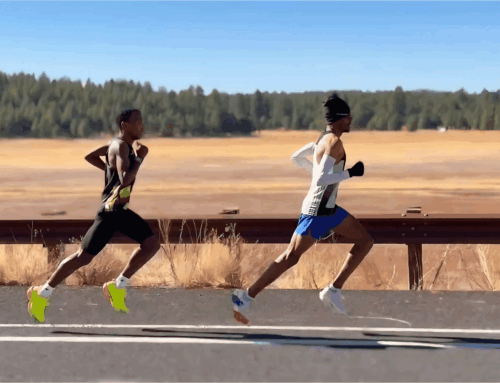Question: How much does shoe weight affect running performance?
Dr. Jack Daniels: As a matter of fact I did the original research on shoe-weight factor, when I was working for Nike in the early 1980s and our research was presented at the World Congress of Sports Medicine in Vienna in the early 1980s. We found adding 100 grams to the shoe increased the aerobic demand of running by 1%. Now 100 grams is about 3.5274 ounces, so each ounce changes the cost of running about 0.2835% (1/3.5274= 0.2835). If you can run a mile in 5:40, that is going 284 meters per minute and that speed of running typically coasts about 55.55 ml O2 per Kg body weight per minute. 1 less ounce will change the cost to about 55.7075 (from 55.55 above) and that VO2 will be associated with a running speed of 284.7 m/min and a mile time of 5:39.17, so about .83 seconds for a mile, per ounce less weight.
NOW, that research involved running in the exact same pairs of shoes with little lead weights inserted into a sleeve sewed onto the sides of the shoe (at the point of center of mass of the shoe so it wouldn’t change the toe or heel drop any). This allowed us to test WEIGHT ADJUSTMENT ONLY. When we tested the aerobic demand of different shoes of different weights, then we found a different story. Basically, as shoe weight went lighter the cost also dropped some, but when the shoe weight went too light, then the cost went up because there was getting to be less midsole cushioning and the runner’s muscles had to start absorbing more landing shock and that costs more energy. It depends on the surface on which you are running. A nice soft artificial track will itself absorb some landing shock so the shoes don’t need to do that for you, but on a street, you need some cushioning and that adds a little weight to the shoe, whereas reducing weight too far actually increases the cost of running, as does the material used in shoe design.
I hope this is simple enough. I think mentioning shoe design and midsole material is an important factor, and the most economical shoe we ever tested had a midsole over 1 inch think and was of a sponge material like you would wash your car with. Those shoes (we referred to as “marshmallow shoes”) we’re not so light, but absorbed so much landing shock that they were a joy to run in. Negative side of those was they did not prevent any pronation and if you did pronate, these shoes just exaggerated the problem — never produced (illegal anyway as they put your heel more than the allowable 20mm above the ground).
Learn more about customizing a training plan, designed by Dr. Jack Daniels on the V.O2 app.





“illegal anyway as they put your heel more than the allowable 20mm above the ground”
Really curious about this statement – illegal to make shoes that put the heel >20mm off the ground?
You need to look up the IAAF rules on shoes, that is where it came from and I only assume it is still the same rule. What it applies to is that you can’t run any world records in shoes that are thicker than a certain amount. It came about many years ago when some high jumpers from another country showed up with high-jumping shoes that had a sole about 3 or 4 inches thick so they were taking off with center of mass a fair bit higher. So the IAAF put in a rule about maximum allowable shoe sole thickness by saying the heel of your foot had to be within so many mm of the ground (which I thought was 20 at the heel and maybe 12 or 15 at the forefoot). It’s certainly legal to wear thicker shoes, but not for any world records.(just as you are not allowed to wear shoes with springs in the midsole). It’s not illegal to produce such a thick shoe.
Good post however , I was wondering if you could write a litte more on this topic?
I’d be very grateful if you could elaborate a little bit further. Kudos!
[…] When you run, your leg acts as a pendulum and every time you lift your leg you have to pick up the weight of your shoe. Thus, one of the easiest ways to run faster is to simply wear lighter shoes. According to Jack Daniels, the legendary coach, not the distiller, for every ounce of shoe weight reduced, you’ll run .83 seconds faster per mile. […]
I’d rather add one second per mile for the additional cushioning….since I’m not trying to post any world records. 🙂
With the new era of minimalist shoes I have strayed from them, needing decent cusioning in a trainer shoe I put many miles in. Recently have turned to a more lightweight racing shoe but not minimalist by any means. Wondering the Dr.’s thoughts on adding small amounts of weight to my trainers to see an even bigger benefit when putting on the racing pair? I am equating this similarly to when I was a kid playing ball. In the on-deck circle putting the weighted donut on the bat and swinging, then taking it off and the feeling of a super light bat. Appreciate any comments. Obviously injury would be concern if placed off center or too much at once.
[…] famous running coach Jack Daniels, says that a runner expends 1 percent more aerobic energy for every 100 g of weight on a shoe. While this may seem insignificant, the truth is that in a marathon every little thing is […]
Does this mean 0.83 sec per ounce, per shoe or per pair of shoes? In other words, will 10oz shoes be 0.83sec/mile or 1.66sec/mile faster than 11oz shoes?
Thanks much in advance for clarification.
Brian, it’s per ounce less weight total.
[…] Read more here […]